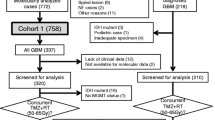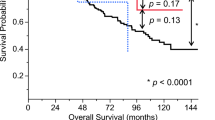Abstract
TERT promoter mutations are one of the most common genetic alterations in adult-type diffuse gliomas and show specific patterns compared with other genetic alterations according to glioma subtypes. This mutation has variable impacts on patient outcomes in association with other genetic alterations, including IDH1/2 mutations or histological types. The purpose of this paper is to review the current knowledge on the values of TERT promoter mutations in the diagnosis and prognostication of adult-type diffuse gliomas. We also aimed to discuss the interaction between the prognostic impacts of TERT promoter mutations and other molecular alterations. Although its impact on prognosis is somewhat complicated and enigmatic, the mutational status of the TERT promoter provides highly useful information for predicting patients’ outcomes in the conventional classification of gliomas defined by IDH1/2 and 1p/19q status.


Similar content being viewed by others
References
Louis DN, Perry A, Wesseling P et al (2021) The 2021 WHO classification of tumors of the central nervous system: a summary. Neuro Oncol. https://doi.org/10.1093/neuonc/noab106
Horn S, Figl A, Rachakonda PS et al (2013) TERT promoter mutations in familial and sporadic melanoma. Science 339:959–961. https://doi.org/10.1126/science.1230062
Huang FW, Hodis E, Xu MJ et al (2013) Highly recurrent TERT promoter mutations in human melanoma. Science 339:957–959. https://doi.org/10.1126/science.1229259
Koelsche C, Sahm F, Capper D et al (2013) Distribution of TERT promoter mutations in pediatric and adult tumors of the nervous system. Acta Neuropathol. https://doi.org/10.1007/s00401-013-1195-5
Arita H, Narita Y, Fukushima S et al (2013) Upregulating mutations in the TERT promoter commonly occur in adult malignant gliomas and are strongly associated with total 1p19q loss. Acta Neuropathol 126:267–276. https://doi.org/10.1007/s00401-013-1141-6
Killela PJ, Reitman ZJ, Jiao Y et al (2013) TERT promoter mutations occur frequently in gliomas and a subset of tumors derived from cells with low rates of self-renewal. Proc Natl Acad Sci USA 110:6021–6026. https://doi.org/10.1073/pnas.1303607110
Remke M, Ramaswamy V, Peacock J et al (2013) TERT promoter mutations are highly recurrent in SHH subgroup medulloblastoma. Acta Neuropathol. https://doi.org/10.1007/s00401-013-1198-2
Sahm F, Schrimpf D, Olar A et al (2016) TERT promoter mutations and risk of recurrence in meningioma. J Natl Cancer Inst. https://doi.org/10.1093/jnci/djv377
Arita H, Yamasaki K, Matsushita Y et al (2016) A combination of TERT promoter mutation and MGMT methylation status predicts clinically relevant subgroups of newly diagnosed glioblastomas. Acta Neuropathol Commun 4:79. https://doi.org/10.1186/s40478-016-0351-2
Labussiere M, Di Stefano AL, Gleize V et al (2014) TERT promoter mutations in gliomas, genetic associations and clinico-pathological correlations. Br J Cancer 111:2024–2032. https://doi.org/10.1038/bjc.2014.538
Lee J, Putnam AR, Chesier SH et al (2018) Oligodendrogliomas, IDH-mutant and 1p/19q-codeleted, arising during teenage years often lack TERT promoter mutation that is typical of their adult counterparts. Acta Neuropathol Commun 6:95. https://doi.org/10.1186/s40478-018-0598-x
Nguyen HN, Lie A, Li T et al (2016) Human TERT promoter mutation enables survival advantage from MGMT promoter methylation in IDH1 wild-type primary glioblastoma treated by standard chemoradiotherapy. Neuro Oncol. https://doi.org/10.1093/neuonc/now189
Nonoguchi N, Ohta T, Oh JE et al (2013) TERT promoter mutations in primary and secondary glioblastomas. Acta Neuropathol 126:931–937. https://doi.org/10.1007/s00401-013-1163-0
Simon M, Hosen I, Gousias K et al (2015) TERT promoter mutations: a novel independent prognostic factor in primary glioblastomas. Neuro Oncol 17:45–52. https://doi.org/10.1093/neuonc/nou158
Spiegl-Kreinecker S, Lotsch D, Ghanim B et al (2015) Prognostic quality of activating TERT promoter mutations in glioblastoma: interaction with the rs2853669 polymorphism and patient age at diagnosis. Neuro Oncol 17:1231–1240. https://doi.org/10.1093/neuonc/nov010
Kikuchi Z, Shibahara I, Yamaki T et al (2020) TERT promoter mutation associated with multifocal phenotype and poor prognosis in patients with IDH wild-type glioblastoma. Neurooncol Adv 2:vdaa114. https://doi.org/10.1093/noajnl/vdaa114
Shu C, Wang Q, Yan X et al (2018) The TERT promoter mutation status and MGMT promoter methylation status, combined with dichotomized MRI-derived and clinical features, predict adult primary glioblastoma survival. Cancer Med 7:3704–3712. https://doi.org/10.1002/cam4.1666
Bell RJ, Rube HT, Kreig A et al (2015) Cancer. The transcription factor GABP selectively binds and activates the mutant TERT promoter in cancer. Science 348:1036–1039. https://doi.org/10.1126/science.aab0015
Pierini T, Nardelli C, Lema Fernandez AG et al (2020) New somatic TERT promoter variants enhance the telomerase activity in glioblastoma. Acta Neuropathol Commun 8:145. https://doi.org/10.1186/s40478-020-01022-4
Barthel FP, Wei W, Tang M et al (2017) Systematic analysis of telomere length and somatic alterations in 31 cancer types. Nat Genet 49:349–357. https://doi.org/10.1038/ng.3781
Castelo-Branco P, Choufani S, Mack S et al (2013) Methylation of the TERT promoter and risk stratification of childhood brain tumours: an integrative genomic and molecular study. Lancet Oncol 14:534–542. https://doi.org/10.1016/S1470-2045(13)70110-4
Lee DD, Leao R, Komosa M et al (2019) DNA hypermethylation within TERT promoter upregulates TERT expression in cancer. J Clin Invest 129:223–229. https://doi.org/10.1172/JCI121303
Adachi JI, Shirahata M, Suzuki T et al (2021) Droplet digital PCR assay for detecting TERT promoter mutations in patients with glioma. Brain Tumor Pathol 38:201–209. https://doi.org/10.1007/s10014-021-00403-4
Ichimura K (2019) TERT promoter mutation as a diagnostic marker for diffuse gliomas. Neuro Oncol 21:417–418. https://doi.org/10.1093/neuonc/noz025
Brennan CW, Verhaak RG, McKenna A et al (2013) The somatic genomic landscape of glioblastoma. Cell 155:462–477. https://doi.org/10.1016/j.cell.2013.09.034
Suzuki H, Aoki K, Chiba K et al (2015) Mutational landscape and clonal architecture in grade II and III gliomas. Nat Genet 47:458–468. https://doi.org/10.1038/ng.3273
Higa N, Akahane T, Yokoyama S et al (2020) A tailored next-generation sequencing panel identified distinct subtypes of wildtype IDH and TERT promoter glioblastomas. Cancer Sci 111:3902–3911. https://doi.org/10.1111/cas.14597
Miki S, Satomi K, Ohno M et al (2020) Highly sensitive detection of TERT promoter mutations in recurrent glioblastomas using digital PCR. Brain Tumor Pathol 37:154–158. https://doi.org/10.1007/s10014-020-00375-x
Fontanilles M, Marguet F, Beaussire L et al (2020) Cell-free DNA and circulating TERT promoter mutation for disease monitoring in newly-diagnosed glioblastoma. Acta Neuropathol Commun 8:179. https://doi.org/10.1186/s40478-020-01057-7
Diplas BH, Liu H, Yang R et al (2019) Sensitive and rapid detection of TERT promoter and IDH mutations in diffuse gliomas. Neuro Oncol 21:440–450. https://doi.org/10.1093/neuonc/noy167
Arita H, Matsushita Y, Machida R et al (2020) TERT promoter mutation confers favorable prognosis regardless of 1p/19q status in adult diffuse gliomas with IDH1/2 mutations. Acta Neuropathol Commun 8:201. https://doi.org/10.1186/s40478-020-01078-2
Tesileanu CMS, Dirven L, Wijnenga MMJ et al (2020) Survival of diffuse astrocytic glioma, IDH1/2 wildtype, with molecular features of glioblastoma, WHO grade IV: a confirmation of the cIMPACT-NOW criteria. Neuro Oncol 22:515–523. https://doi.org/10.1093/neuonc/noz200
Stichel D, Ebrahimi A, Reuss D et al (2018) Distribution of EGFR amplification, combined chromosome 7 gain and chromosome 10 loss, and TERT promoter mutation in brain tumors and their potential for the reclassification of IDHwt astrocytoma to glioblastoma. Acta Neuropathol 136:793–803. https://doi.org/10.1007/s00401-018-1905-0
Fujimoto K, Arita H, Satomi K et al (2021) TERT promoter mutation status is necessary and sufficient to diagnose IDH-wildtype diffuse astrocytic glioma with molecular features of glioblastoma. Acta Neuropathol 142:323–338. https://doi.org/10.1007/s00401-021-02337-9
Gomes I, Moreno DA, Dos Reis MB et al (2021) Low MGMT digital expression is associated with a better outcome of IDH1 wildtype glioblastomas treated with temozolomide. J Neurooncol 151:135–144. https://doi.org/10.1007/s11060-020-03675-6
Labussiere M, Boisselier B, Mokhtari K et al (2014) Combined analysis of TERT, EGFR, and IDH status defines distinct prognostic glioblastoma classes. Neurology 83:1200–1206. https://doi.org/10.1212/WNL.0000000000000814
Gramatzki D, Felsberg J, Hentschel B et al (2021) Telomerase reverse transcriptase promoter mutation- and O(6)-methylguanine DNA methyltransferase promoter methylation-mediated sensitivity to temozolomide in isocitrate dehydrogenase-wild-type glioblastoma: is there a link? Eur J Cancer 147:84–94. https://doi.org/10.1016/j.ejca.2021.01.014
Mosrati MA, Malmstrom A, Lysiak M et al (2015) TERT promoter mutations and polymorphisms as prognostic factors in primary glioblastoma. Oncotarget 6:16663–16673. https://doi.org/10.18632/oncotarget.4389
Killela PJ, Pirozzi CJ, Healy P et al (2014) Mutations in IDH1, IDH2, and in the TERT promoter define clinically distinct subgroups of adult malignant gliomas. Oncotarget 5:1515–1525
Umehara T, Arita H, Yoshioka E et al (2019) Distribution differences in prognostic copy number alteration profiles in IDH-wild-type glioblastoma cause survival discrepancies across cohorts. Acta Neuropathol Commun 7:15. https://doi.org/10.1186/s40478-019-0749-8
Lee Y, Koh J, Kim SI et al (2017) The frequency and prognostic effect of TERT promoter mutation in diffuse gliomas. Acta Neuropathol Commun 5:62. https://doi.org/10.1186/s40478-017-0465-1
Barthel FP, Wesseling P, Verhaak RGW (2018) Reconstructing the molecular life history of gliomas. Acta Neuropathol 135:649–670. https://doi.org/10.1007/s00401-018-1842-y
Akyerli CB, Yuksel S, Can O et al (2018) Use of telomerase promoter mutations to mark specific molecular subsets with reciprocal clinical behavior in IDH mutant and IDH wild-type diffuse gliomas. J Neurosurg 128:1102–1114. https://doi.org/10.3171/2016.11.JNS16973
Zhang Z, Chan AK, Ding X et al (2017) Glioma groups classified by IDH and TERT promoter mutations remain stable among primary and recurrent gliomas. Neuro Oncol 19:1008–1010. https://doi.org/10.1093/neuonc/nox042
Korber V, Yang J, Barah P et al (2019) Evolutionary Trajectories of IDH(WT) glioblastomas reveal a common path of early tumorigenesis instigated years ahead of initial diagnosis. Cancer Cell 35:692-704 e612. https://doi.org/10.1016/j.ccell.2019.02.007
Batista R, Cruvinel-Carloni A, Vinagre J et al (2016) The prognostic impact of TERT promoter mutations in glioblastomas is modified by the rs2853669 single nucleotide polymorphism. Int J Cancer 139:414–423. https://doi.org/10.1002/ijc.30057
Pekmezci M, Rice T, Molinaro AM et al (2017) Adult infiltrating gliomas with WHO 2016 integrated diagnosis: additional prognostic roles of ATRX and TERT. Acta Neuropathol 133:1001–1016. https://doi.org/10.1007/s00401-017-1690-1
Fukai J, Arita H, Umehara T et al (2020) Molecular characteristics and clinical outcomes of elderly patients with IDH-wildtype glioblastomas: comparative study of older and younger cases in Kansai Network cohort. Brain Tumor Pathol 37:50–59. https://doi.org/10.1007/s10014-020-00363-1
Hegi ME, Diserens AC, Gorlia T et al (2005) MGMT gene silencing and benefit from temozolomide in glioblastoma. N Engl J Med 352:997–1003. https://doi.org/10.1056/NEJMoa043331
Hsu CP, Hsu NY, Lee LW et al (2006) Ets2 binding site single nucleotide polymorphism at the hTERT gene promoter–effect on telomerase expression and telomere length maintenance in non-small cell lung cancer. Eur J Cancer 42:1466–1474. https://doi.org/10.1016/j.ejca.2006.02.014
Nencha U, Rahimian A, Giry M et al (2016) TERT promoter mutations and rs2853669 polymorphism: prognostic impact and interactions with common alterations in glioblastomas. J Neurooncol 126:441–446. https://doi.org/10.1007/s11060-015-1999-3
Aoki K, Nakamura H, Suzuki H et al (2017) Prognostic relevance of genetic alterations in diffuse lower-grade gliomas. Neuro Oncol. https://doi.org/10.1093/neuonc/nox132
Eckel-Passow JE, Lachance DH, Molinaro AM et al (2015) Glioma groups based on 1p/19q, IDH, and TERT promoter mutations in tumors. N Engl J Med 372:2499–2508. https://doi.org/10.1056/NEJMoa1407279
Wijnenga MMJ, Dubbink HJ, French PJ et al (2017) Molecular and clinical heterogeneity of adult diffuse low-grade IDH wild-type gliomas: assessment of TERT promoter mutation and chromosome 7 and 10 copy number status allows superior prognostic stratification. Acta Neuropathol 134:957–959. https://doi.org/10.1007/s00401-017-1781-z
Brat DJ, Aldape K, Colman H et al (2018) cIMPACT-NOW update 3: recommended diagnostic criteria for “Diffuse astrocytic glioma, IDH-wildtype, with molecular features of glioblastoma, WHO grade IV.” Acta Neuropathol 136:805–810. https://doi.org/10.1007/s00401-018-1913-0
Berzero G, Di Stefano AL, Ronchi S et al (2021) IDH-wildtype lower-grade diffuse gliomas: the importance of histological grade and molecular assessment for prognostic stratification. Neuro Oncol 23:955–966. https://doi.org/10.1093/neuonc/noaa258
Maida Y, Yasukawa M, Okamoto N et al (2014) Involvement of telomerase reverse transcriptase in heterochromatin maintenance. Mol Cell Biol 34:1576–1593. https://doi.org/10.1128/MCB.00093-14
Acknowledgements
This investigation was supported by JSPS KAKENHI 20K09324 (HA).
Author information
Authors and Affiliations
Corresponding author
Ethics declarations
Conflict of interest
The authors declare that they have no conflicts of interest.
Additional information
Publisher's Note
Springer Nature remains neutral with regard to jurisdictional claims in published maps and institutional affiliations.
Rights and permissions
About this article
Cite this article
Arita, H., Ichimura, K. Prognostic significance of TERT promoter mutations in adult-type diffuse gliomas. Brain Tumor Pathol 39, 121–129 (2022). https://doi.org/10.1007/s10014-021-00424-z
Received:
Accepted:
Published:
Issue Date:
DOI: https://doi.org/10.1007/s10014-021-00424-z




